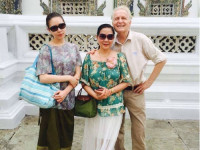javaandroid中opencv的使用
来源:互联网 发布:凌慕枫叶知秋全文免费 编辑:程序博客网 时间:2024/05/29 02:09
opencv使用帮助
http://docs.opencv.org/
opencv图片灰度化:
package com.testopencv.haveimgfun; public class LibImgFun { static { System.loadLibrary("ImgFun"); } /** * @param width the current view width * @param height the current view height */ public static native int[] ImgFun(int[] buf, int w, int h); } class ClickEvent implements View.OnClickListener { public void onClick(View v) { if (v == btnNDK) { long current = System.currentTimeMillis(); Bitmap img1 = ((BitmapDrawable) getResources().getDrawable( R.drawable.lena)).getBitmap(); int w = img1.getWidth(), h = img1.getHeight(); int[] pix = new int[w * h]; img1.getPixels(pix, 0, w, 0, 0, w, h); int[] resultInt = LibImgFun.ImgFun(pix, w, h); Bitmap resultImg = Bitmap.createBitmap(w, h, Config.RGB_565); resultImg.setPixels(resultInt, 0, w, 0, 0, w, h); long performance = System.currentTimeMillis() - current; imgView.setImageBitmap(resultImg); HaveImgFun.this.setTitle("w:" + String.valueOf(img1.getWidth()) + ",h:" + String.valueOf(img1.getHeight()) + "NDK耗时" + String.valueOf(performance) + " 毫秒"); } else if (v == btnRestore) { Bitmap img2 = ((BitmapDrawable) getResources().getDrawable( R.drawable.lena)).getBitmap(); imgView.setImageBitmap(img2); HaveImgFun.this.setTitle("使用OpenCV进行图像处理"); } } LibImgFun代码:
#include <jni.h>#include <stdio.h>#include <stdlib.h>#include <opencv2/opencv.hpp>using namespace cv;IplImage * change4channelTo3InIplImage(IplImage * src);extern "C" {JNIEXPORT jintArray JNICALL Java_com_testopencv_haveimgfun_LibImgFun_ImgFun( JNIEnv* env, jobject obj, jintArray buf, int w, int h);JNIEXPORT jintArray JNICALL Java_com_testopencv_haveimgfun_LibImgFun_ImgFun( JNIEnv* env, jobject obj, jintArray buf, int w, int h) { jint *cbuf; cbuf = env->GetIntArrayElements(buf, false); if (cbuf == NULL) { return 0; } Mat myimg(h, w, CV_8UC4, (unsigned char*) cbuf); IplImage image=IplImage(myimg); IplImage* image3channel = change4channelTo3InIplImage(&image); IplImage* pCannyImage=cvCreateImage(cvGetSize(image3channel),IPL_DEPTH_8U,1); cvCanny(image3channel,pCannyImage,50,150,3); int* outImage=new int[w*h]; for(int i=0;i<w*h;i++) { outImage[i]=(int)pCannyImage->imageData[i]; } int size = w * h; jintArray result = env->NewIntArray(size); env->SetIntArrayRegion(result, 0, size, outImage); env->ReleaseIntArrayElements(buf, cbuf, 0); return result;}}IplImage * change4channelTo3InIplImage(IplImage * src) { if (src->nChannels != 4) { return NULL; } IplImage * destImg = cvCreateImage(cvGetSize(src), IPL_DEPTH_8U, 3); for (int row = 0; row < src->height; row++) { for (int col = 0; col < src->width; col++) { CvScalar s = cvGet2D(src, row, col); cvSet2D(destImg, row, col, s); } } return destImg;}来自:http://blog.csdn.net/watkinsong/article/details/9849973
二值化:
#include "opencv2/opencv.hpp" using namespace cv; void Java_com_test_MainActivity(JNIEnv* env jclass jthis){ Mat mat = imread("/test.jpg"); mat = mat >50; //二值化 imwrite("out.jpg",mat); } 人脸检测:
package com.tcl.uviewer.features.featuresImpl;import org.opencv.core.Core;import org.opencv.core.Mat;import org.opencv.core.MatOfRect;import org.opencv.core.Point;import org.opencv.core.Scalar;import org.opencv.highgui.Highgui;import org.opencv.objdetect.CascadeClassifier;public class Test{public static void detectFace(String imagePath){System.out.println("\nRunning DetectFaceDemo");// 导入opencv的库System.loadLibrary(Core.NATIVE_LIBRARY_NAME);// 从配置文件lbpcascade_frontalface.xml中创建一个人脸识别器,该文件位于opencv安装目录中CascadeClassifier faceDetector = new CascadeClassifier("C:/lbpcascade_frontalface.xml");Mat image = Highgui.imread(imagePath);// 在图片中检测人脸MatOfRect faceDetections = new MatOfRect();faceDetector.detectMultiScale(image, faceDetections);System.out.println(String.format("Detected %s faces",faceDetections.toArray().length));// 在每一个识别出来的人脸周围画出一个方框for (org.opencv.core.Rect rect : faceDetections.toArray()){Core.rectangle(image, new Point(rect.x, rect.y), new Point(rect.x+ rect.width, rect.y + rect.height), new Scalar(0, 255, 0));}// 将结果保存到文件String filename = "faceDetection.png";System.out.println(String.format("Writing %s", filename));Highgui.imwrite(filename, image);}public static void main(String[] args){String imagePath = "C:/005.jpg";Test.detectFace(imagePath);}} System.loadLibrary(Core.NATIVE_LIBRARY_NAME); System.out.println("\nRunning FaceDetector"); CascadeClassifier faceDetector = new CascadeClassifier(FaceDetector.class.getResource("haarcascade_frontalface_alt.xml").getPath()); Mat image = Highgui .imread(FaceDetector.class.getResource("shekhar.JPG").getPath()); MatOfRect faceDetections = new MatOfRect(); faceDetector.detectMultiScale(image, faceDetections); System.out.println(String.format("Detected %s faces", faceDetections.toArray().length)); for (Rect rect : faceDetections.toArray()) { Core.rectangle(image, new Point(rect.x, rect.y), new Point(rect.x + rect.width, rect.y + rect.height), new Scalar(0, 255, 0)); } String filename = "ouput.png"; System.out.println(String.format("Writing %s", filename)); Highgui.imwrite(filename, image);识别结果: 
来源:
http://yuanhuan.blog.51cto.com/3367116/1301368
http://yjdingkai.iteye.com/blog/1532450
http://www.cnblogs.com/endless-on/p/3491154.html
人脸识别匹配代码:
public double CmpPic(String path) { int l_bins = 20; int hist_size[] = { l_bins }; float v_ranges[] = { 0, 100 }; float ranges[][] = { v_ranges }; IplImage Image1 = cvLoadImage(Environment.getExternalStorageDirectory() + "/FaceDetect/faceDone.jpg", CV_LOAD_IMAGE_GRAYSCALE); IplImage Image2 = cvLoadImage(path, CV_LOAD_IMAGE_GRAYSCALE); IplImage imageArr1[] = { Image1 }; IplImage imageArr2[] = { Image2 }; CvHistogram Histogram1 = CvHistogram.create(1, hist_size, CV_HIST_ARRAY, ranges, 1); CvHistogram Histogram2 = CvHistogram.create(1, hist_size, CV_HIST_ARRAY, ranges, 1); cvCalcHist(imageArr1, Histogram1, 0, null); cvCalcHist(imageArr2, Histogram2, 0, null); cvNormalizeHist(Histogram1, 100.0); cvNormalizeHist(Histogram2, 100.0); return cvCompareHist(Histogram1, Histogram2, CV_COMP_CORREL); } 参考:http://blog.csdn.net/sky286753213/article/details/11887913
demo下载地址:http://download.csdn.net/detail/sky286753213/6617075
androidstudio opencv demo:
https://github.com/quanhua92/OpenCV_Java_AndroidStudio
how to use opencv-java in androidstudio?:
http://www.quan404.com/2015/07/how-to-use-opencv-android-in-android.html
opencv的匹配图片:
mMatches为识别结果 /** * * 对场景图片帧进行相关处理 * 其中在这里获取匹配对 * 然后绘制获取的线框 */ @Override public void apply(final Mat src, final Mat dst) { Imgproc.cvtColor(src, mGraySrc, Imgproc.COLOR_RGBA2GRAY); mFeatureDetector.detect(mGraySrc, mSceneKeypoints); mDescriptorExtractor.compute(mGraySrc, mSceneKeypoints, mSceneDescriptors); mDescriptorMatcher.match(mSceneDescriptors, mReferenceDescriptors, mMatches); findSceneCorners(); draw(src, dst); } private void findSceneCorners() { List<DMatch> matchesList = mMatches.toList(); // 匹配对太少 if (matchesList.size() < 4) { // There are too few matches to find the homography. return; } // 将MatOfKeyPoint数据结构存储的特征点数据转换成List,便于后面获取 List<KeyPoint> referenceKeypointsList = mReferenceKeypoints.toList(); List<KeyPoint> sceneKeypointsList = mSceneKeypoints.toList(); // Calculate the max and min distances between keypoints. // 计算特征点之间的最大和最小距离 double maxDist = 0.0; double minDist = Double.MAX_VALUE; for(DMatch match : matchesList) { double dist = match.distance; if (dist < minDist) { minDist = dist; } if (dist > maxDist) { maxDist = dist; } } // The thresholds for minDist are chosen subjectively // based on testing. The unit is not related to pixel // distances; it is related to the number of failed tests // for similarity between the matched descriptors. // 根据距离对角点进行取舍 if (minDist > 50.0) { // The target is completely lost. // Discard any previously found corners. mSceneCorners.create(0, 0, mSceneCorners.type()); return; } else if (minDist > 25.0) { // The target is lost but maybe it is still close. // Keep any previously found corners. return; } // Identify "good" keypoints based on match distance. ArrayList<Point> goodReferencePointsList = new ArrayList<Point>(); ArrayList<Point> goodScenePointsList = new ArrayList<Point>(); // 最佳距离极限为minDist的1.75倍,然后拾取在此范围的点到ArrayList中 double maxGoodMatchDist = 1.75 * minDist; for(DMatch match : matchesList) { if (match.distance < maxGoodMatchDist) { goodReferencePointsList.add( referenceKeypointsList.get(match.trainIdx).pt); goodScenePointsList.add( sceneKeypointsList.get(match.queryIdx).pt); } } // 如果在范围内的(拾取到的)点数小于4,则表示没有发现标志 if (goodReferencePointsList.size() < 4 || goodScenePointsList.size() < 4) { // There are too few good points to find the homography. return; } // 再从ArrayList转换成MatOfPoint2f数据结构(OpenCV中),同样是为了后面的处理 // 一个是参考图片的点数据,一个是图像帧的点数据 MatOfPoint2f goodReferencePoints = new MatOfPoint2f(); goodReferencePoints.fromList(goodReferencePointsList); MatOfPoint2f goodScenePoints = new MatOfPoint2f(); goodScenePoints.fromList(goodScenePointsList); // 计算单应性矩阵,根据最佳参考图像和场景图片的特征点(需要描述) Mat homography = Calib3d.findHomography( goodReferencePoints, goodScenePoints); /** * 根据单应性矩阵对参考图像帧进行透视变换,将2D场景转换成3D * 保存在mCandidateSceneCorners */ Core.perspectiveTransform(mReferenceCorners, mCandidateSceneCorners, homography); // 对mCandidateSceneCorners进行类型转换 mCandidateSceneCorners.convertTo(mIntSceneCorners, CvType.CV_32S); // 输入数据(四边形)必须是凸面 if (Imgproc.isContourConvex(mIntSceneCorners)) { mCandidateSceneCorners.copyTo(mSceneCorners); } }显示结果: 
参考:http://arvrschool.com/read.php?tid=163&fid=52
0 0
- javaandroid中opencv的使用
- javaAndroid实现刚刚发表几天前的日期工具类
- OpenCV中SVM的使用
- OpenCV中SVM的使用
- opencv 中sift 的使用
- openCV中IplImage的使用
- openCV中IplImage的使用
- OpenCV 中CV_IMAGE_ELEM 的使用
- OpenCV中OpenMP的使用
- MFC中OpenCV的使用
- openCV中IplImage的使用
- Opencv中gemm的使用
- openCV中IplImage的使用
- WINX中使用OpenCV的一个样例
- WINX中使用OpenCV的一个样例
- WINX中使用OpenCV的一个样例
- WINX中使用OpenCV的一个样例
- WINX中使用OpenCV的一个样例
- android SurfaceHolder与SurfaceView对象介绍
- Tomcat在CentOS7下的安装
- 关于APP接口防止抓包问题
- Swift基础
- gearmand工作原理
- javaandroid中opencv的使用
- Ubuntu eclipse里面调试android应用,Logcat只显示级别
- Linux下面运行shell脚本出现unexpected end of file错误
- Eclipse Ctrl+Space 无法工作的问题
- 技术人员怎样转型成为产品经理?
- 分享我基于NPOI+ExcelReport实现的导入与导出EXCEL类库:ExcelUtility
- HTML meta标签总结与属性的使用介绍
- 莫队学习总结(一) :清橙A1206.小Z的袜子 && CF 86D
- 非常好的Java反射例子


